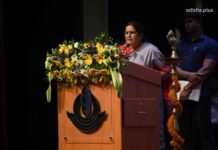Dr. Fakira Mohan Nahak
THE TELEVISION NEWS INDUSTRY IN ODISHA HAS GONE THROUGH A PROGRESSIVE JOURNEY IN THE PAST TWO DECADES. IN THIS SERIES, DR. FAKIRA MOHAN NAHAK PRESENTS THE MEDIA HISTORY BLENDED WITH HIS CLOSE OBSERVATION ON THE FAST-CHANGING INDUSTRY.

Religion is a belief and purely a personal choice or affair. It is up to the individual to decide which religion to follow. Being a secular state, India ensures the freedom of religion to every citizen. It’s one of the fundamental rights and there are specific articles in the Constitution of India that guarantees the freedom of religion. However, growing incidents of religious intolerance has been impedance to the growth of our society and the nation at large.
There are cases of forced religious conversions and gharwapsi, the process of reconverting to the original faith. In the name of religion, there is religious fundamentalism which ultimately disrupts the religious harmony. The marginalised section of the society and the tribals are more vulnerable to the process of religious conversions. It leads to conflicts, debates, riots, and violence between people of different religions.
A tragic incident took place in the village of Manoharpur on the late winter night of January 22, 1999 in the hills of Kendujhar district. Graham Stuart Staines, an Australian Christian missionary, and his two minor sons, Philip and Timothy, were burnt alive while inside a vehicle. The basic reason behind the heinous crime has a root in the religion.

The incident at the time caused a stir not only in Odisha but all over the world. It has been widely condemned in various parts of the world. The state government has to be humiliated. This incident is a disgraceful chapter in the history of Odisha. At the time of the incident, newspapers, All India Radio and Doordarshan were the only media in Odisha. ETV Oriya was not even born.
The Central Bureau of Investigation (CBI) was tasked with investigating the incident. The CBI had filed a charge sheet against 18 people, including Rabindra Kumar Pal alias Dara Singh, the main accused in the case. About a year after the incident, Dara Singh was arrested on January 30, 2000 in the forest of Mayurbhanj. Trial in the case began in the district and sessions court, Khordha.

Judging the case, the Khordha district sessions court judge Mahendra Nath Patnaik delivered the final verdict on September 22, 2003. Thirteen of the eighteen defendants were convicted and others were acquitted. The court, however, awarded death sentence to the main accused Dara Singh and sentenced the other 12 to life imprisonment. The day the verdict was announced was a test for ETV.
Being an infotainment channel, there were scheduled and predefined number of news bulletins. So it was not easy to go on air for big breaking news in the unallocated hours. However, in view of the seriousness of the case, the pressure and competition at the national level, the broadcast was approved by the ETV programming Head.

The telecast might happen at any moment once the verdict is out. So the approval was taken accordingly. That’s how even not being a 24*7 news channel; ETV became the first to give the big Breaking News to the viewers as soon as the verdict was pronounced in the court. As the news telecast was not in the usual slots of the ETV, it was a thrilling experience when the news broke. From the beginning of the case, Jayadev Behera, the then crime reporter of ETV covered it. On the verdict day also, he reported it with utmost care and precision.
However, other accused, including Dara Singh, approached the Orissa High Court against the verdict of the lower court. After nearly three years of trial, the High Court finally ruled on May 19, 2005.
The High Court set aside the death sentence given to Dara Singh in the lower court and commuted it to life imprisonment. However the High Court upheld the life sentence awarded to Mahendra Hembram, one of the other 12 convicted in the lower court while eleven other defendants were acquitted.

On the day of the verdict, ETV outperformed all the Odia and national media. Every media house’s focus was on the verdict. However, ETV’s proper planning and coordination between News station, Bhubaneswar and Cuttack bureau office and the focused efforts of ETV representative Tapan Swain in Cuttack, the channel managed to telecast the news first to the viewers.
Not only that, Krishna Chandra Sahu, the then Balasore bureau chief of the channel, was able to meet Dara Singh, the main accused inside the Baripada Circle Jail in Mayurbhanj and took his exclusive interview.

At that time, ETV was the only channel that interviewed Dara Singh from inside the prison cell to find out what were the motive of him and his associates behind the heinous crime. Similarly, a special interview was held with one of the accused, Mahendra Hembram, from inside the Choudwar Circle Jail, Cuttack. That was not the end of the story.
On May 21, the PTI (Press Trust of India) released a report on the Graham Staines murder. It attributed the interviews conducted by ETV, as well as excerpts from it. As the popularity of television in Odisha grew, so did the excitement, interest and visible rivalry over the news coverage in any such media. Yes, it is a chapter in history…
(Dr. Fakira Mohan Nahak is a writer and former media professional. He is currently working as the Head of the Department of University Institute of Media Studies, Chandigarh University at Mohali, Punjab. Views are Personal)
Tags: #GrahamStuartStaines #JailRoom #GrahamStainesmurder #DaraSingh #DrFakirMohanNahak #HelloIndia #Television #ETVOdia #Reporting #murderofStaines #ChoudwarCircleJail #KrishnaChandraSahu #TapanSwain

























